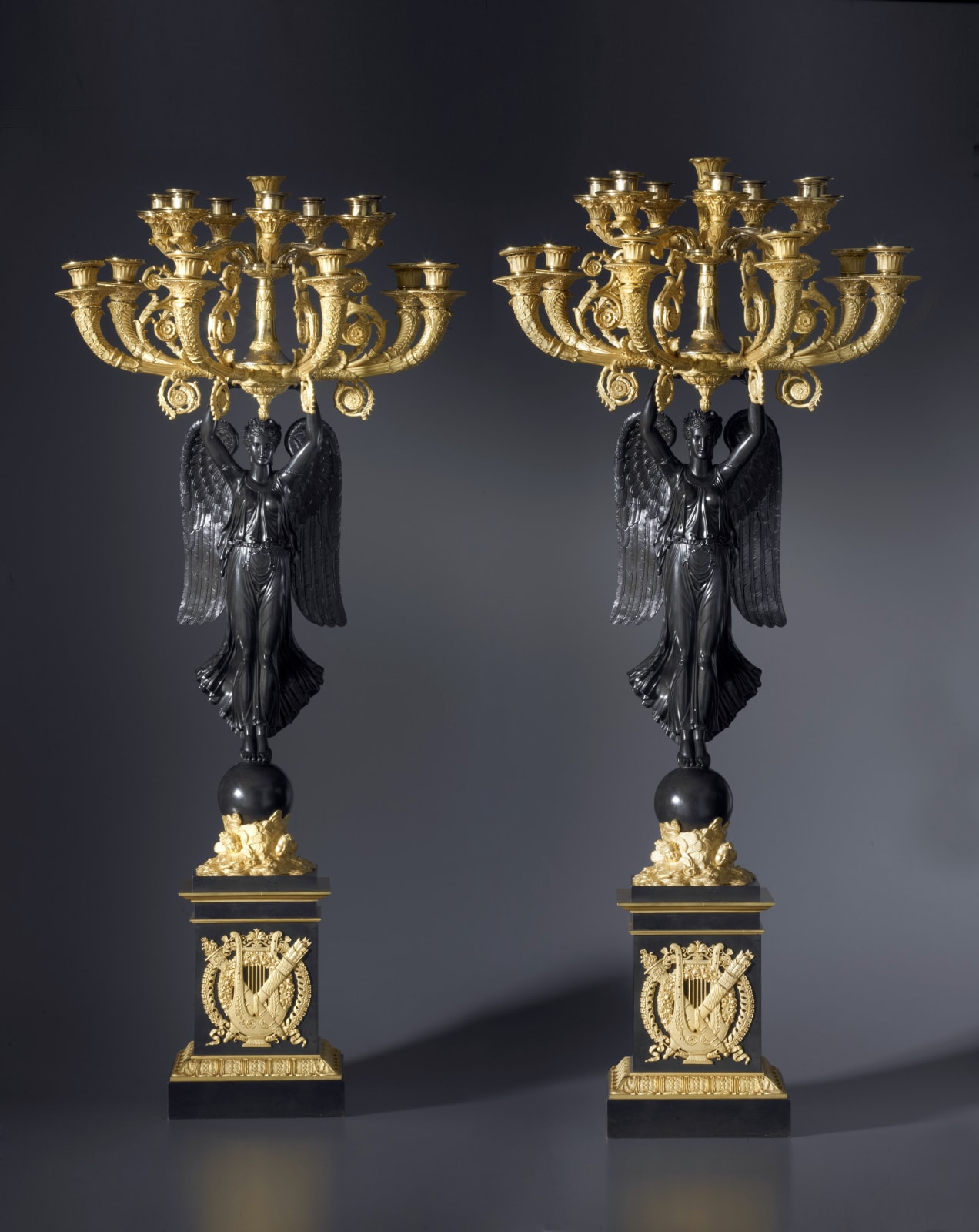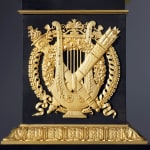Pierre-Philippe Thomire (attributed to) French, 1731-1843
Literature
Hans Ottomeyer and Peter Pröschel, "Vergoldete Bronzen", 1986, p. 329, pl. 5.2.4, illustrating a very similar pair of ten-light candelabra à la Victoire by Pierre-Philippe Thomire of circa 1810 in the Metropolitan Museum, New York. And p. 328, pl. 5.2.1, illustrating two related studies from a detail on a sheet of designs by Charles Percier of circa 1802 for furnishings for Joséphine Bonaparte's boudoir at Château de Saint Cloud, now in the Metropolitan Museum, New York. And p. 328, pl. 5.2.2, illustrating one of a pair of closely related candelabra with Victory standing on one foot and noting that a related drawing of those candelabra appear in Thomire's album of 1817, now in the Stockholm Nationalmuseum.
A large and important pair of Empire gilt and patinated bronze fourteen-light candelabra attributed to Pierre-Philippe Thomire after a design by Charles Percier, each with a patinated winged figure of Victory wearing diaphanous robes holding aloft fourteen gilt and foliate-wrapped branched lights composed of a central upright shaft terminated by a vase-shaped candle holder issuing a ring of seven scrolled branches above a lower ring of six lights, each classical figure standing on tip-toe, with both feet upon a sphere within a gilt cherub cloud, on a patinated rectangular pedestal mounted with a gilt ribbon-tied double floral wreath surmounted by a palmette flanked by a pair of butterflies, centred by a lyre and crossed by a flaming torch and quiver of arrows, on a stepped square base with foliate border
Paris, date circa 1810
Height 116.5 cm. each.
The personification of Victory as a winged figure was well known to in Antiquity as evidenced by a Roman model showing a very similar model upon a sphere, now in the National Art Collection, Kassel (illustrated ibid. p. 329, pl. 5.2.3). The figure became an integral element within Empire design through the intervention of Charles Percier (1764-1838) and Pierre François Léonard Fontaine (1762-1853), Napoleon's most important architects and designers. The design for the present pair of candelabra is derived from a design by Charles Percier, as cited above.
Given their superb quality and close comparison with other examples, these candelabra are almost certainly the work of the preeminent bronzier Pierre-Philippe Thomire (1751-1843), who significantly often worked from Percier and Fontaine designs. Close inspection reveals the mastery of the chasing, from the free flowing robes that subtly outline the female form and the seemingly naturalistic feathered wings to the detailed cherub cloud, the floral wreaths complete with intricate butterflies. In addition to the pair in the Metropolitan Museum are another pair of similar form at Château de Fontainebleau, which was acquired in 1804 for the salon de l'Impératrice (J. P. Samoyault, "Pendules et Bronzes d'Ameublement Entrés sous le Premier Empire", 1989, p. 156, no. 133). A further related pair of candelabra was sold from Sheringham Hall, Norfolk in October 1986.
Pierre-Philippe Thomire was the greatest craftsman of his age to work in gilt bronze. He was patronised by Louis XVI, Napoleon and Louis XVIII as well as foreign monarchy and aristocracy. Born in Paris, he began his training under the sculptors Jean-Antoine Houdon (1741-1828) and Augustin Pajou (1730-1809) at the Académie Saint-Luc, Paris and then followed his father's profession as a fondeur-ciseleur. He studied under the great fondeur-doreur, Pierre Gouthière (1732-1813/14), from whom he acquired the most refined skills in chasing and gilding, in particular matt gilding 'dorure au matt', to produce a subtle grainy satin-like finish.
Appointed a maître-fondeur in 1772, he set up his own business in 1776 following his collaboration with Jean-Louis Prieur in the decoration of the coronation coach for Louis XVI. Other royal commissions followed; for instance he supplied gilt bronze chenets with flaming urns and sphinxes for the Louvre in 1786. His fame and notoriety was then propelled to even greater heights after the Revolution when in 1806 he became the first bronzier to be awarded a gold medal at the Exposition des Produits de l'Industrie. In 1809 he won another gold medal and was also appointed ciseleur de l'Empereur. In addition to Napoleon himself Thomire was patronised by the Emperor's family and many foreign royal courts.



